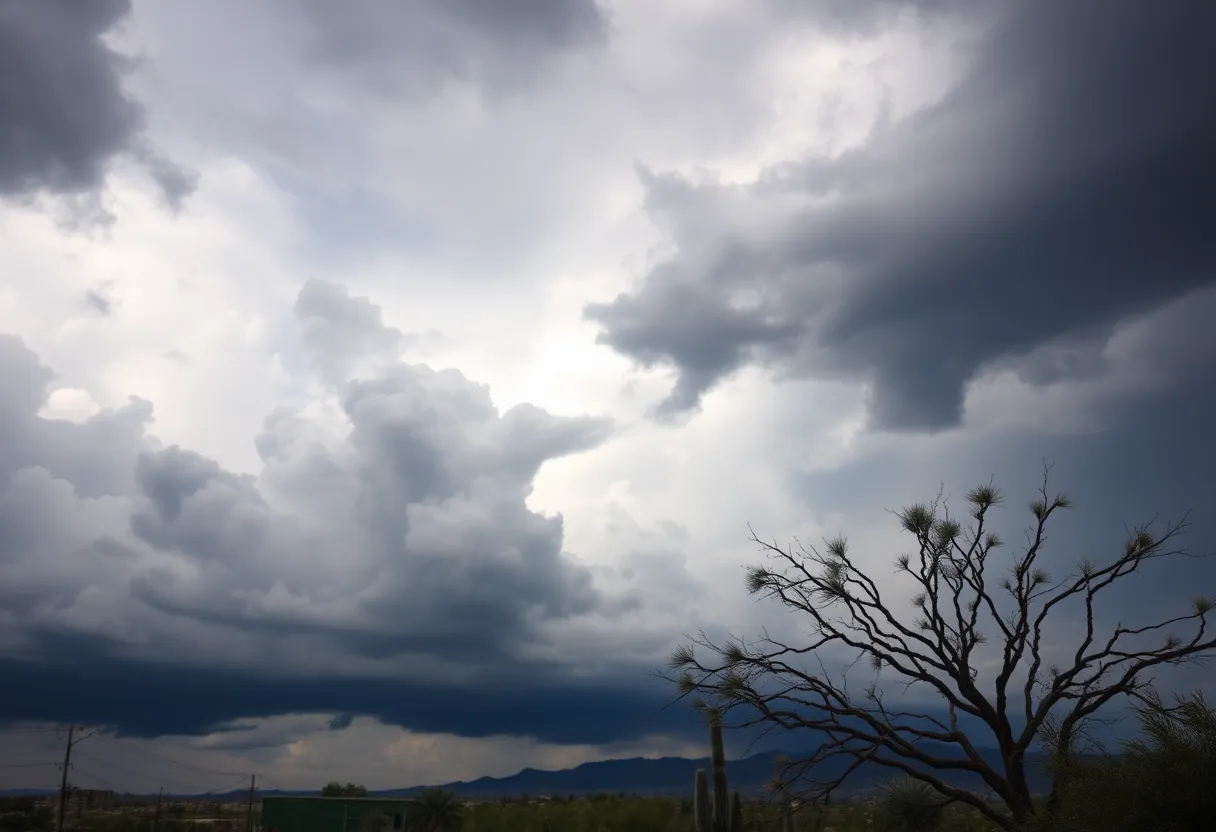Tucson, October 14, 2025
Severe storms have wreaked havoc in Tucson and nearby areas, triggering rare tornado warnings for Tucson, Phoenix, and Tempe. High winds toppled trees and caused power outages for thousands, though no injuries were reported. Emergency services responded swiftly to flooded streets, showcasing the community’s preparedness for such unexpected weather events. Meteorologists are linking these unusual storms to shifting climate patterns that may lead to similar occurrences in the future.
Severe Storms Bring Tornado Warnings to Tucson and Nearby Areas
Tucson, AZ – Severe storms struck the region on October 14, 2025, issuing rare tornado warnings for Tucson, Phoenix, and Tempe. High winds toppled trees and caused power outages affecting 10,000 residents, but no injuries were reported. Emergency services quickly responded to flooded streets, highlighting the storm’s widespread impact across the Southwest.
The most critical effects included the sudden high winds that uprooted trees and disrupted power supplies, leaving many households without electricity. These outages began as the storms intensified, with officials noting the rapid progression of the weather event. Flooded streets added to the challenges, as water levels rose quickly, requiring immediate intervention from local emergency teams to ensure public safety.
Supporting details reveal that the storms were unexpected for the area, given the region’s typical weather patterns. Meteorologists explained that the event involved strong wind gusts capable of toppling large trees, which in turn blocked roads and damaged property. The power outages affected neighborhoods in Tucson, Phoenix, and Tempe, with restoration efforts underway to restore services as quickly as possible. No major structural damage was reported beyond the fallen trees, and the absence of injuries was attributed to timely warnings and community preparedness.
Background context shows that such severe weather is unusual for the Southwest, where tornado warnings are rare. Meteorologists linked this event to a shifting climate pattern that has been influencing weather in the region. This pattern involves changes in atmospheric conditions that can lead to more intense storms, even in areas not typically prone to them. Historically, the Southwest experiences dry conditions, making events like this a notable deviation and a potential indicator of broader environmental shifts.
In recent days, the buildup to this storm included increased monitoring by weather experts, who tracked the developing system across the area. The storms’ origins can be traced to larger weather systems moving through the United States, bringing unusual moisture and instability to Arizona. This context underscores the importance of advanced forecasting tools that helped alert residents in advance, minimizing risks.
Local responses were swift and coordinated, with emergency services deploying teams to handle the flooded streets and clear debris. These efforts prevented any escalation, ensuring that the community could recover without long-term disruptions. The event serves as a reminder of how weather events can vary, even in arid regions like the Southwest, and the need for ongoing preparedness.
Further details from the storm’s aftermath indicate that while power was restored to most areas within hours, some residents experienced delays due to extensive damage. The high winds reached speeds that were uncommon for the season, contributing to the outages. Meteorologists continue to study the shifting climate pattern, suggesting that similar events might become more frequent in the future, prompting discussions on adaptive measures for Arizona communities.
Overall, the storms on October 14, 2025, demonstrated the vulnerability of urban areas to sudden weather changes. With no injuries and a focus on quick recovery, the response highlighted effective emergency protocols in Tucson, Phoenix, and Tempe. As the region deals with the cleanup, experts emphasize the role of climate awareness in preventing future impacts.
To expand on the event’s significance, it is worth noting that the tornado warnings were among the first of their kind in recent years for these cities. This rarity adds to the story, as residents are more accustomed to heatwaves than severe storms. The involvement of 10,000 residents affected by outages underscores the scale, while the lack of injuries reflects positive outcomes from preparedness efforts. Moving forward, this incident may influence local policies on weather resilience and infrastructure upgrades to handle such events better.
In conclusion, the severe storms of October 14, 2025, brought unexpected challenges to Tucson and surrounding areas, but the coordinated response ensured minimal harm. This event provides valuable lessons on climate-related risks and the importance of community readiness in the face of changing weather patterns.
Frequently Asked Questions
-
What happened in Tucson on October 14, 2025?
Severe storms brought rare tornado warnings to Tucson, Phoenix, and Tempe, with high winds toppling trees and causing power outages for 10,000 residents.
-
Were there any injuries reported?
No injuries were reported from the storms.
-
How did emergency services respond?
Emergency services responded to flooded streets caused by the storms.
-
What caused the severe storms?
Meteorologists link the event to a shifting climate pattern affecting the Southwest.
-
Which areas were affected?
The storms affected Tucson, Phoenix, and Tempe.
Key Features Chart
| Feature | Description |
|---|---|
| Tornado Warnings | Rare event in Tucson, Phoenix, and Tempe on October 14, 2025 |
| High Winds | Toppled trees and caused power outages for 10,000 residents |
| Injuries | No injuries reported |
| Emergency Response | Responded to flooded streets |
| Climate Link | Linked to a shifting climate pattern affecting the Southwest |
Deeper Dive: News & Info About This Topic
HERE Resources
Funnel Cloud Spotted Over Pima County




